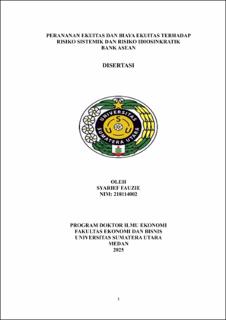Peranan Ekuitas dan Biaya Ekuitas Terhadap Risiko Sistemik dan Risiko Idiosinkratik Bank ASEAN
The Role of Equity and Cost of Equity in Systemic Risk and Idiosyncratic Risk of ASEAN Banks

Date
2025Author
Fauzie, Syarief
Advisor(s)
Pratomo, Wahyu Ario
Hasyim, Sirojuzilam
Ruslan, Dede
Metadata
Show full item recordAbstract
This study aims to analyse the influence of equity and cost of equity on two dimensions of banking risk, namely systemic risk and idiosyncratic risk, while taking into account the institutional characteristics of banks in ASEAN countries. Using annual panel data from 55 publicly listed banks across five ASEAN countries during the 2012–2022 period, a two-step System Generalised Method of Moments (System GMM) dynamic panel regression approach is employed to address endogeneity and simultaneity bias. This research highlights the moderating role of market power, franchise value, and liquidity hoarding behaviour in the relationship between capital structure and banking risk.
The results indicate that the impact of equity and capital structure on risk varies significantly across institutional segments. Among banks with high market power and strong franchise value, equity is found to increase systemic risk, pointing to a moral hazard of capital effect. Conversely, for banks operating in competitive markets with limited liquidity, capital ratios such as the capital adequacy ratio (CAR) and Tier-1 capital act as disciplinary instruments that reduce risk, particularly idiosyncratic risk. The cost of equity calculated using the CAPM consistently increases both types of risk, while fundamental-based models such as Claus & Thomas (2001) and Gebhardt et al. (2001) tend to mitigate risk, especially in banks with weak market and capital structures.
Findings further show that CAR and Tier-1 ratios can play dual roles: either as buffers or as drivers of risk, depending on institutional context and market pressure. Banks with high liquidity and high cost of capital tend to utilise expansion space to take on greater risk. This study contributes to the development of a segmented approach to banking risk supervision by proposing a risk typology based on institutional attributes. The policy implication underlines the importance of designing regulatory frameworks that are adaptive to the institutional structure of banks in order to achieve sustainable financial system stability.
